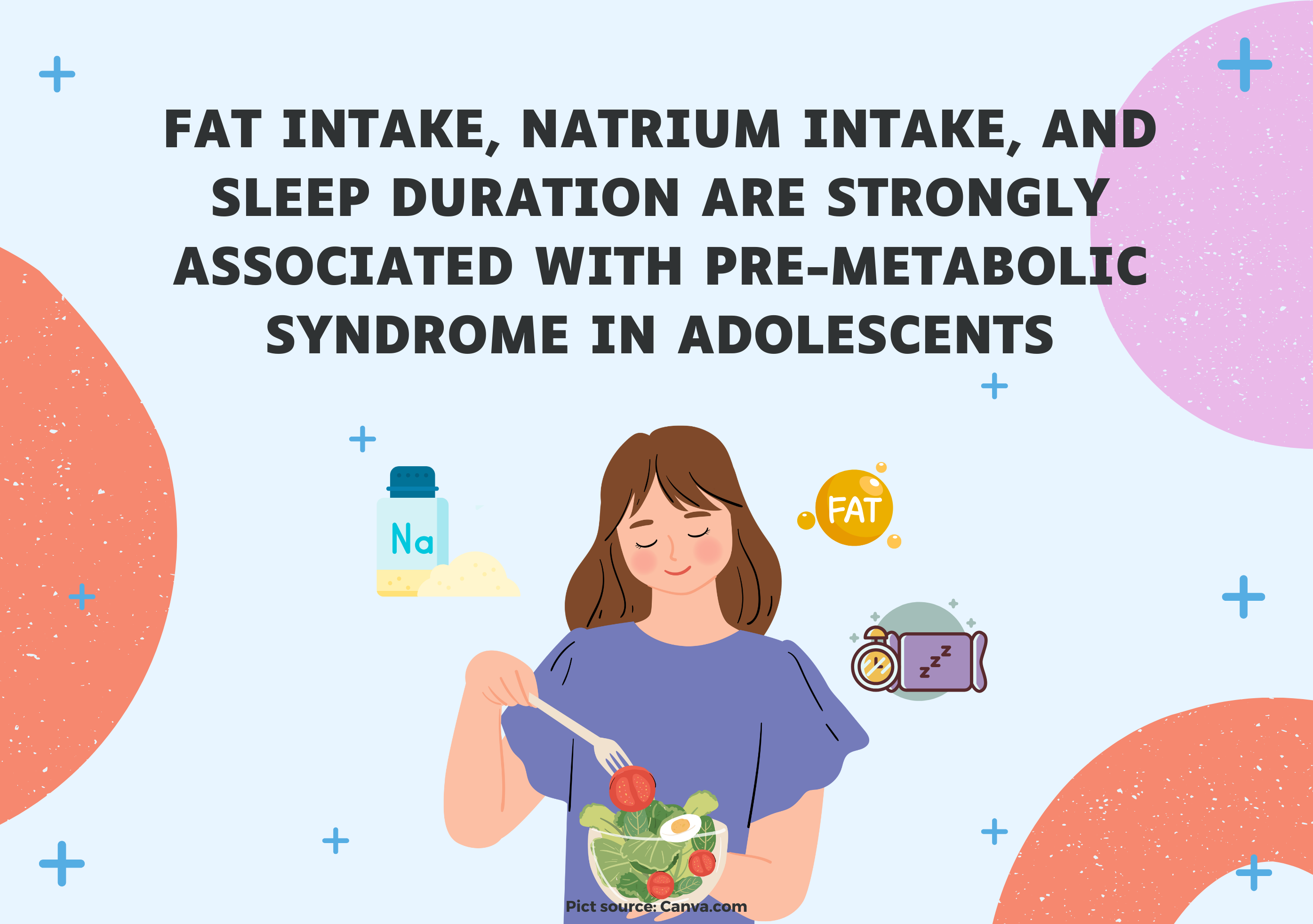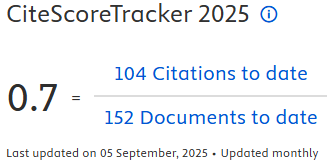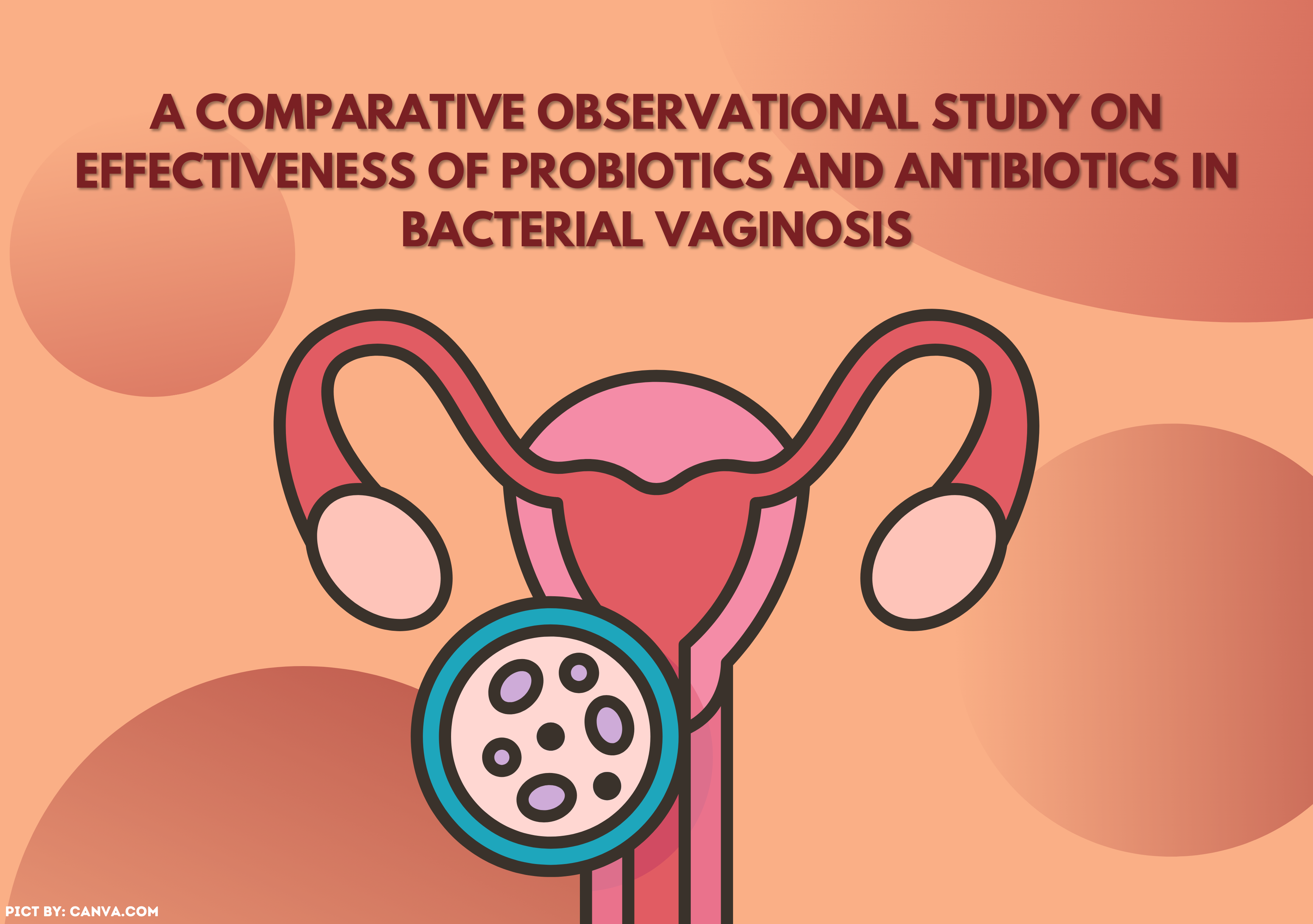FAT INTAKE, NATRIUM INTAKE, AND SLEEP DURATION ARE STRONGLY ASSOCIATED WITH PRE-METABOLIC SYNDROME IN ADOLESCENTS

Downloads
Introduction: The prevalence of pre-metabolic syndrome components, such as abdominal obesity and elevated blood pressure, in teenagers is increasing yearly. One of the modifiable risk factors to pre-metabolic syndrome is lifestyle, including dietary intake, physical activity, and sleep duration. Based on preliminary study, 80% (12 of 15) students were found to have high blood pressure. Aims: The objective of this study was to evaluate the relationship between nutrition and lifestyle factors with pre-metabolic syndrome in high school students. Methods: This study was cross-sectional design with 90 adolescents as respondents. Instruments used in this study were sphygmomanometer and waist ruler to measure blood pressure and waist circumference; 3x24 hours of food record and SQ-FFQ to observe dietary intake; modified PSQI to assess sleep duration; and modified IPAQ to know physical activity score in respondents. All data were statistically analyzed with Spearman correlation test. Results: The findings of this study were fat intake, fulfillment of fat requirement (% of fat requirement), natrium intake, and sleep duration were significantly associate with pre-metabolic syndrome occurrence in adolescents (p<0.05). Coefficient correlation showed positive for fat intake, % of fat requirement, and natrium intake (respectively 0.705; 0.511; 0.854) and negative for sleep duration (-0.819). Conclusion: there are association between fat intake, fulfillment of fat requirement (% of fat requirement), natrium intake, and sleep duration with pre-metabolic syndrome in adolescents. This study findings may be used as evaluation for government nutrition programs for adolescents.
Adamska-Patruno, E. et al. (2018) ‘The Relationship between the Leptin/Ghrelin Ratio and Meals with Various Macronutrient Contens in Men with Differentt Nutritional Status: a Randomized Crossover Study’, Nutrition Journal, 17(1), pp. 1–7. https://doi.org/10.1186/s12937-018-0427-x
Adhi, D.H. (2012) Asupan Zat Gizi Makro, Serat, Indeks Glikemik Pangan Hubungannya dengan Persen Lemak Tubuh pada Polisi Laki-Laki Kabupaten Purworejo Tahun 2012. Universitas Indonesia.
Al-Bachir, M. and Ahmad, H. (2021) ‘Reliability and Validity of the International Physical Activity Questionnaire for Adults in Syria’, International Journal of Health Promotion and Education, 61(6). https://doi.org/10.1080/14635240.2021.1989610
Asghari, G. et al. (2021) ‘Adolescent Metabolic Syndrome and Its Components Associations with Incidence of Type 2 Diabetes in Early Adulthood: Tehran Lipid and Glucose Study’, Diabetology and Metabolic Syndrome, 13(1), pp. 1–9. https://doi.org/10.1186/s13098-020-00608-1
Brown, J.E. (2011) Nutrition through the Life Cycle. 4th edn. Belmont: Wadsworth Cengage Learning.
Cabej, N. (2019) Epigenetics Principles of Evolution. https://doi.org/10.1016/B978-0-12-814067-3.00014-4
Cai, Z., Huang, Y. and He, B. (2022) ‘New Insights into Adipose Tissue Macrophages in Obesity and Insulin Resistance’, Cells, 11(9). https://doi.org/10.3390/cells11091424
Chaput, J. P. et al. (2023) ‘The Role of Insufficient Sleep and Circadian Misalignment in Obesity’, Nature Reviews Endocrinology, 19(2), pp. 82–97. https://doi.org/10.1038/s41574-022-00747-7
Che, T. et al. (2021) ‘The Association Between Sleep and Metabolic Syndrome: A Systematic Review and Meta-Analysis’, Frontiers in Endocrinology, 12(November), pp. 1–11. https://doi.org/10.3389/fendo.2021.773646
Cho, J. et al. (2017) ‘Insulin Resistance and Its Association with Metabolic Syndrome in Korean Children’, BioMed Research International, 2017. https://doi.org/10.1155/2017/8728017
Daly, A.N., O’Sullivan, E.J. and Kearney, J.M. (2022) ‘Considerations for Health and Food Choice in Adolescents’, Proceedings of the Nutrition Society, 81(1), pp. 75–86. https://doi.org/10.1017/S0029665121003827
Fang, K. et al. (2021) ‘Relationship of Sodium Intake with Overweight/Obesity among Chinese Children and Adolescents: Data from the CNNHS 2010-2012’, International Journal of Environmental Research and Public Health, 18(9). https://doi.org/10.3390/ijerph18094551
FAO (2015) Food Based Dietary Guidelines-Indonesia. FAO.
Farhangi, M.A. (2019) ‘Night Eating Syndrome and Its Relationship with Emotional Eating, Sleep Quality and Nutritional Status Among Adolescents’ Boys’, Community Mental Health Journal, 55(8), pp. 1411–1418. https://doi.org/10.1007/s10597-019-00395-8
Farhangi, M.A., Nikniaz, L. and Khodarahmi, M. (2020) ‘Sugar-Sweetened Beverages Increases the Risk of Hypertension among Children and Adolescence: A Systematic Review and Dose-Response Meta-Analysis’, Journal of Translational Medicine, 18(1), pp. 1–18. https://doi.org/10.1186/s12967-020-02511-9
Fuentes-Servín, J. et al. (2021) ‘Resting Energy Expenditure Prediction Equations in the Pediatric Population: A Systematic Review’, Frontiers in Pediatrics, 9(December). https://doi.org/10.3389/fped.2021.795364
Hajishizari, S. et al. (2022) ‘The Association of Appetite and Hormones (Leptin, Ghrelin, and Insulin) with Restign Metabolic Rate in Overweight/Obese Women: a Case-Control Study’, BMC Nutrition, 8(1), pp. 1–12. https://doi.org/10.1186/s40795-022-00531-w
Harraqui, K. et al. (2023) ‘Association between Physical Activity, Body Composition, and Metabolic Disorders in Middle-Aged Women of Ksar el Kebir (Morocco)’, International Journal of Environmental Research and Public Health, 20(3). https://doi.org/10.3390/ijerph20031739
Indonesian Pediatric Society (2014) Diagnosis dan Tata laksana Sindrom Metabolik pada Anak dan Remaja, Konsensus Ikatan Dokter Anak Indonesia. Jakarta.
Julibert, A. et al. (2019) ‘Total and Subtypes of Dietary Fat Intake and Its Association with Components of the Metabolic Syndrome in a Mediterranean Population at High Cardiovascular Risk’, Nutrients, 11(7). https://doi.org/10.3390/nu11071493
Jumarsih, B.S. (2021) Faktor-Faktor yang Berhubungan dengan Nilai Glukosa Darah Sewaktu pada Penyandang Diabetes Mellitus di Puskesmas Teluk Pucung Tahun 2021. Universitas Muhammadiyah Jakarta.
Kaur, J. (2014) ‘Assessment and Screening of the Risk Factors in Metabolic Syndrome’, Medical Sciences, 2(3), pp. 140–152. https://doi.org/10.3390/medsci2030140
Ministry of Health Republic Indonesia (2013) Riset Kesehatan Dasar. Jakarta.
Ministry of Health Republic Indonesia (2018) Riset Kesehatan Dasar. Jakarta.
Khusun, H. et al. (2023) ‘Breakfast Consumption and Quality of Macro-and Micronutrient Intake in Indonesia: a Study from the Indonesian Food Barometer’, Nutrients, 15(3792), pp. 1–16. https://doi.org/10.3390/nu15173792
Konieczna, J. et al. (2019) ‘Longitudinal Association of Changes in Diet with Changes in Body Weight and Waist Circumference in Subjects at High Cardiovascular Risk: The PREDIMED Trial’, International Journal of Behavioral Nutrition and Physical Activity, 16(1), pp. 1–13. https://doi.org/10.1186/s12966-019-0893-3
Kotsis, V. et al. (2010) ‘Mechanisms of Obesity-Induced Hypertension’, Hypertension Research, 33(5), pp. 386–393. https://doi.org/10.1038/hr.2010.9
Lee, J. et al. (2018) ‘Associations of Urinary Sodium Levels with Overweight and Central Obesity in a Population with a Sodium Intake’, BMC Nutrition, 4(1), pp. 1–14. https://doi.org/10.1186/s40795-018-0255-6
Lee, J. et al. (2023) ‘The Association between Dietary Sodium Intake and Obesity in Adults by Sodium Intake Assessment Methods: a Review of Systematic Reviews and Re-Meta-Analysis’, Nutrition Research and Practice, 17(2), pp. 175–191. https://doi.org/10.4162/nrp.2023.17.2.175
Liu, M. et al. (2021) ‘Associations Between Sleep Duration, Wake-Up Time, Bedtime, and Abdominal Obesity: Results From 9559 Chinese Children Aged 7–18 Years’, Frontiers in Endocrinology, 12(October), pp. 1–9. https://doi.org/10.3389/fendo.2021.735952
Mahan, L.K. and Raymond, J.L. (2017) Krause’s Food & The Nutrition Care Process. Elsevier. https://doi.org/10.1016/j.jneb.2019.06.022
El Meouchy, P. et al. (2022) ‘Hypertension Related to Obesity: Pathogenesis, Characteristics and Factors for Control’, International Journal of Molecular Sciences, 23(20). https://doi.org/10.3390/ijms232012305
Mohamed, S.M. et al. (2023) ‘Metabolic Syndrome: Risk Factors, Diagnosis, Pathogenesis, and Management with Natural Approaches’, Food Chemistry Advances, 3(May). https://doi.org/10.1016/j.focha.2023.100335
Mohamed, W.S., Hassanien, M.A. and Abokhosheim, K.E.S. (2014) ‘Role of Ghrelin, Leptin and Insulin Resistance in Development of Metabolic Syndrome in Obese Patients’, Endocrinology & Metabolic Syndrome, 03(01), pp. 1–6. https://doi.org/10.4172/2161-1017.1000122
Muhammad, H.F.L. et al. (2020) ‘The Impact of Sleep Quality and Duration on Leptin, Appetite, and Obesity Indices in Adults’, Medical Journal of Indonesia, 29(4), pp. 417–421. https://doi.org/10.13181/mji.oa.203707
Mukanu, M.M. et al. (2022) ‘Determinants of Dietary Patterns in School Going Adolescents in Urban Zambia’, Frontiers in Nutrition, 9(956109), pp. 1–14. https://doi.org/10.3389/fnut.2022.956109
Neta, A.DC.P.A. et al. (2021) ‘Dietary Patterns among Adolescents and Associated Factors: Longitudinal Study on Sedentary Behavior, Physical Activity, Diet, and Adolescent Health’, Ciencia e Saude Coletiva, 26(2), pp. 3839–3851. https://doi.org/10.1590/1413-81232021269.2.24922019
de Oliveira, I.D.R. et al. (2023) ‘Association between Abdominal Obesity, Screen Time and Sleep in Adolescents’, Jornal de Pediatria, 99(1), pp. 45–52. https://doi.org/10.1016/j.jped.2022.02.007
Parvanova, A. et al. (2024) ‘Mechanisms and Treatment of Obesity-related Hypertension—Part 1: Mechanisms’, Clinical Kidney Journal, 17(1), pp. 1–18. https://doi.org/10.1093/ckj/sfad282
Purandar, S. and Ganesan, A. (2022) ‘A Cross Sectional Study to Estimate the Prevalence of Metabolic and Pre-Metabolic Syndrome among Young Adults in Rural Population of Chengalpattu District’, Romanian Journal of Diabetes, Nutrition and Metabolic Diseases, 29(2), pp. 202–206.
Ramírez-López, G., Flores-Aldana, M. and Salmerón, J. (2019) ‘Associations between Dietary Patterns and Metabolic Syndrome in Adolescents’, Salud Publica de Mexico, 61(5), pp. 619–628. https://doi.org/10.21149/9541
Ren, H. et al. (2023) ‘Association of Normal-Weight Central Obesity with Hypertension: a Cross-Sectional Study from the China Health and Nutrition Survey’, BMC Cardiovascular Disorders, 23(1), pp. 1–11. https://doi.org/10.1186/s12872-023-03126-w
Rus, M. et al. (2023) ‘Prevalence and Risk Factors of Metabolic Syndrome: A Prospective Study on Cardiovascular Health’, Medicina, 59(10), pp. 1–13. https://doi.org/10.3390/medicina59101711
Sember, V. et al. (2020) ‘Validity and Reliability of International Physical Activity Questionnaires for Adults Across EU Countries: Systematic review and Meta Analysis’, International Journal of Environmental Research and Public Health, 17(19), pp. 1–23. https://doi.org/10.3390/ijerph17197161
Shabrina, K.N., Mulyani, S. and Perdana, M. (2019) ‘Pengaruh Pendidikan Kesehatan Audiovisual terhadap Konsumsi Natrium pada Populasi dengan Risiko Tinggi Sindrom Metabolik di Puskesmas Turi’, Jurnal Keperawatan Klinis dan Komunitas, 3(2), p. 55281. https://doi.org/10.22146/jkkk.44317
Shariq, O.A. and McKenzie, T. J. (2020) ‘Obesity-related Hypertension: A Review of Pathophysiology, Management, and the Role of Metabolic Surgery’, Gland Surgery, 9(1), pp. 80–93. https://doi.org/10.21037/gs.2019.12.03
Shoelson, S.E., Herrero, L. and Naaz, A. (2007) ‘Obesity, Inflammation, and Insulin Resistance’, Gastroenterology, 132(6), pp. 2169–2180. https://doi.org/10.1053/j.gastro.2007.03.059
Sinai, T. et al. (2021) ‘Dietary Patterns among Adolescents are Associated with Growth, Socioeconomics Features, and Health Related Behaviors’, Foods, 10(12), pp. 1–11. https://doi.org/10.3390/foods10123054
Singh, N. et al. (2013) ‘Prevalence of Metabolic Syndrome in Adolescents Aged 10-18 Years in Jammu, J and K’, Indian Journal of Endocrinology and Metabolism, 17(1), p. 133. https://doi.org/10.4103/2230-8210.107849
Sitar-Tǎut, A.V. et al. (2021) ‘New Insights on the Relationship between Leptin, Ghrelin, and Leptin/Ghrelin ratio Enforced by Body Mass Index in Obesity and Diabetes’, Biomedicines, 9(11). https://doi.org/10.3390/biomedicines9111657
Suyoto, P.S.T. et al. (2016) ‘Relative Validity of Administered Indonesian Version of the Short-Form International Physical Activity Questionnaire (IPAQ-SF) among Obese Adolescent Girl Population’, Pakistan Journal of Nutrition, 15(9), pp. 816–820. https://doi.org/10.3923/pjn.2016.816.820
Wang, Y. et al. (2020) ‘Waist Circumference Change is Associated with Blood Pressure Change Independent of BMI Change’, Obesity, 28(1), pp. 146–153. https://doi.org/10.1002/oby.22638
Yeung, A.Y. and Tadi, P. (2023) Physiology, Obesity Neurohormonal Appetite And Satiety Control. StatPearls Publishing.
Yujin, K. et al. (2020) ‘Associating Intake Proportion of Carbohydrate, Fat, and Protein with All-Cause Mortality in Korean Adults’,
Nutrients, 12(3208), pp. 1–12. https://doi.org/10.3390/nu12103208
Zhu, Z. et al. (2021) ‘Dietary Sodium Intake is Positively Associated with Sugar-Sweetened Beverage Consumption in Chinese Children and Adolescents’, Nutrients, 13(11). https://doi.org/10.3390/nu13113949
Copyright (c) 2025 The Indonesian Journal of Public Health

This work is licensed under a Creative Commons Attribution-NonCommercial-ShareAlike 4.0 International License.
- The authors agree to transfer the transfer copyright of the article to The Indonesian Journal of Public Health effective if and when the paper is accepted for publication.
- Authors and other parties are bound to the Creative Commons Attribution-NonCommercial-ShareAlike 4.0 International License for the published articles, legal formal aspect of journal publication accessibility refers to Creative Commons Attribution-NonCommercial-ShareAlike 4.0 International License (CC BY-NC-SA), implies that:
- Attribution ” You must give appropriate credit, provide a link to the license, and indicate if changes were made. You may do so in any reasonable manner, but not in any way that suggests the licensor endorses you or your use.
- NonCommercial ” You may not use the material for commercial purposes.
- ShareAlike ” If you remix, transform, or build upon the material, you must distribute your contributions under the same license as the original.































